Contour RollerMouse Free -- 'Book Mystique Review
Wednesday, March 10, 2010
by Charles W. Moore
I use a variety of pointing devices with my Macs, having been afflicted polyneuritis, myofacial pain syndrome, and fibromyalgia for years. Pain levels tend to wax and wane, with my choice of hardware for pointing and clicking depending greatly on the degree of wrist and arm pain I’m experiencing at any given time.
On better days, I’m inclined to use conventional mice and/or the trackpad in my laptops, but when the pain is really getting me down, one pointing device I find more comfortable and less irritating is Contour’s RollerMouse rollerbar -- a whole different breed in terms of point, click and scroll body-English, in many ways more akin to laptop trackpad — another category of Central Pointing Device (CPD) — than to conventional mice and trackballs.
Rollerbars are not as familiar to most computer users as other “alternative” pointing devices like trackballs, but the broad strokes are that they consist of a round bar situated between the computer keyboard and the user, who manipulates the cursor through a combination of rolling the bar on its axis and sliding it laterally back and forth. The rollerbar moves the cursor by sliding left to right, up and down, and diagonally (simultaneous slide and roll).
The operation is actually a lot more intuitive than it sounds, and the theory is that rollerbars reduce physical stress, especially on wrists, elbows, and shoulders, by eliminating much of the twisting and reaching necessary when using any mouse -- conventional or ergonomic.
Contour Design’s RollerMouse rollerbar device was developed in Sweden, designed to be used with standard computer keyboards that have a rectangular form factor and a straight edge on the user side. I find Kensington’s excellent SlimType keyboard and the very similar i-Rocks X-Slim IMini Keyboard work very well with RollerMouse, but a wide selection of keyboards are compatible.
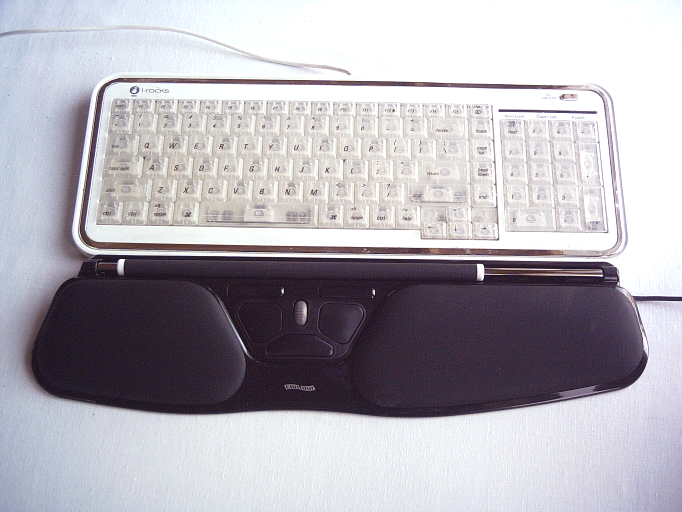
Winner of the 2008 National Ergonomics Conference Attendees Choice Award for Best New Product., the RollerMouse controls the cursor without the need to grip or reach for a mouse. Button controls are centrally located beneath keyboard’s spacebar and the unit’s rollerbar, which can be manipulated using either hand and whatever combination of thumb, fingers, or palm control is most comfortable for the user. This facility for spreading mousing stress between both hands and various digits is a key element in reducing the overall stress on the user’s body. While it is definitely different, the function of this rig is really quite intuitive, and I encountered no learning curve to speak of, but then I’m used to working with trackpads in laptops.
The rollerbar action is silky-smooth and almost effortless. The buttons, with the exception of the scroll wheel button (I assume that it’s intentionally stiffer) have a light touch and a short travel, which I prefer.
The RollerMouse also facilitates easy two-handed mousing, which I am used to. My customary setup is to have both left and right handed mice, plus a foot mouse, hooked up at my office workstation, and I use all three simultaneously to spread the stress on my fibromyalgia-plagued limbs and digits. When I’m using the RollerMouse,it takes the place of the left-hand mouse, but it’s completely adequate to be used on its own in lieu of a mouse or trackball.
A minor criticism is that the RollerMouse has no USB repeater port (although the Pro model has a PS2 one that isn’t any use to us Mac-users), so it eats up another USB port in your system. Unfortunately, this is a pretty general trend in USB peripherals these days, but on a device as expensive as the RollerMouse, it wouldn’t be too much to expect a USB repeater, since there seems to be plenty of room for one.
The RollerMouse I’ve been using for years is the Classic model, which has now been superseded by the 20” x 9” http://ergo.contourdesign.com/products/product-detail.aspx?id=2 RollerMouse Pro2 model.
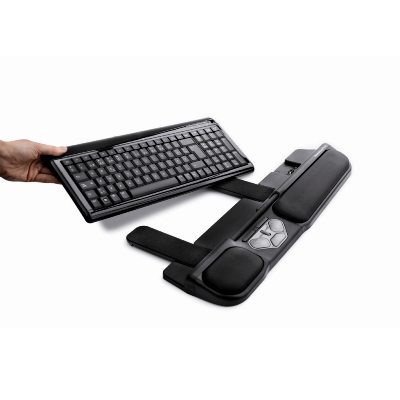
However, now there’s also the more compact — 15” x 4.5” with wrist rests, 15” x 3” without wrist rests -- RollerMouse Free, which is the subject of this review, and which addresses the original RollerMouse’s most substantial shortcoming -- its sheer size -- not out of line with a lot of the contemporary median size of computer keyboards back in 2002, I suppose, but mighty bulky, which made using it where disk space was at a premium something of a challenge.
Another issue was limited access to the rollerbar itself, which had only a relatively narrow open aperture directly above the button pad and was otherwise enclosed.
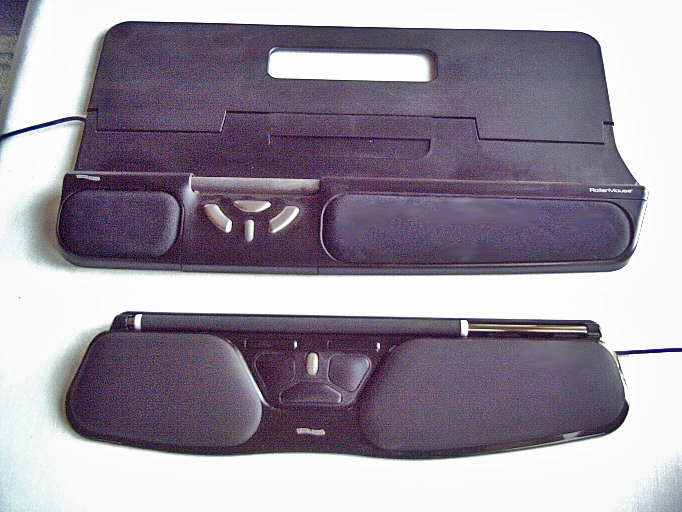
Happily, the RollerMouse Free positively addresses both of these complaints. It’s much more compact than the old original RollerMouse, and the rollerbar is openly accessible across its entire width. Lateral travel remains roughly the same at 9 cm vs. 9.3 cm for old and new models respectively.
The RollerMouse Free has been designed to fit immediately adjacent to your keyboard or laptop. This places the mousing controls just a few inches below the home keys on a regular keyboard, keeping your hands within a small work area, eliminating large reaching motions. It’s not quite as handy when used with a laptop, making it a it of a reach from rollerbar to keyboard, but it’s still quite usable.
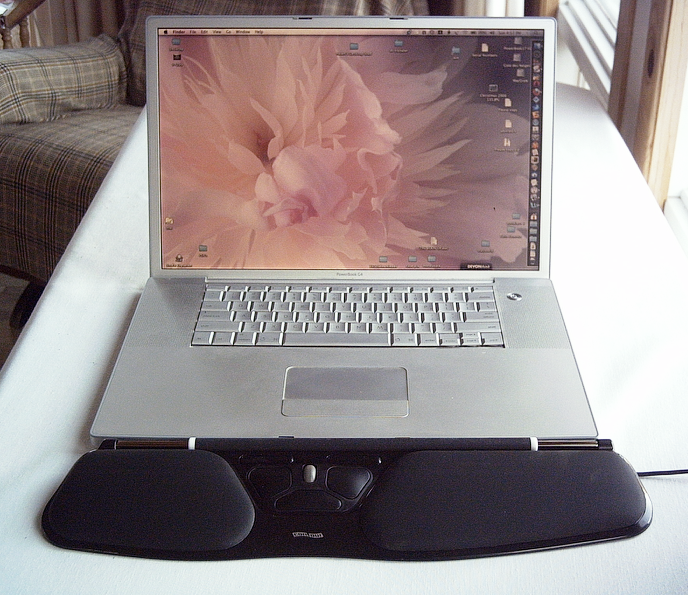
One dissonant aspect of roller mousing is running out of lateral rollerbar travel before one reaches the edge of the screen when mousing slowly. Due to varying monitor sizes, the cursor sometimes hits an invisible wall. However, the RollerMouse’s end of travel detection feature addresses this by automatically performing the equivalent of lifting and repositioning a conventional mouse when the boundaries of your mouse pad are reached. Upon reaching the limit of rollerbar travel at either end, just continue pressing, a light “click” will be detected, and the cursor will continue its journey to the edge of the screen -- an important refinement with today’s high-resolution widescreen displays. Roller mousing works great, and no one should have any worries about trouble adapting to it. The Rollermouse Pro 2 has a wider roller bar incidentally.
The original RollerMouse has a large plastic apron surface behind the wrist rest, button pad, and rollerbar module upon which one rests the keyboard to be used with it. RollerMouse Free dispenses with that. You just position the unit in front of your keyboard, with or without its wrist support attached. In either instance, it demands much less desk space than the older unit, although paradoxically, the new RollerMouse Free has both a larger button pad and more generously sized wrist rest than the original.
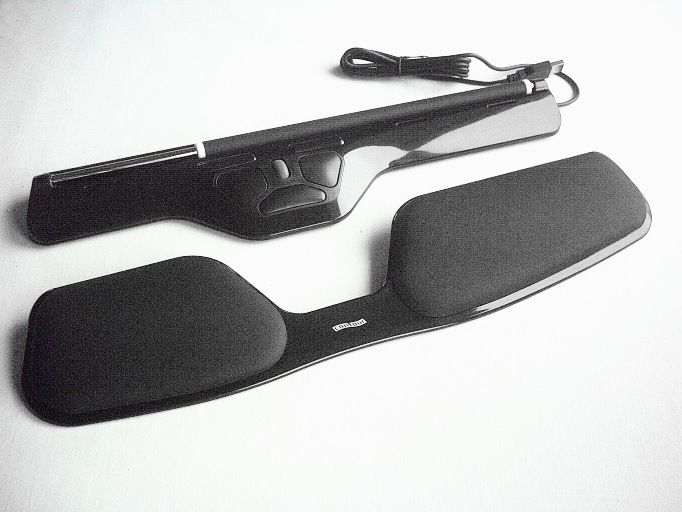
The wrist support module attaches or detaches quickly and easily with three snap connectors. Personally, I use a wrist rest with all freestanding keyboards that don’t have one of their own. I’ve been an almost exclusive laptop user for so long that it feels weird not having a wrist rest. My customary wrist rest is one I made myself for from well-seasoned pine wood, and which has developed a nice, hand-friendly patina over the years, but it’s not much of an adjustment for me to switch to using the RollerMouse instead with its wrist rest attached.
My preference is to have the plane of the keyboard keys slightly lower than wrist rest elevation, but if you have one of the newer crop of untrathin-profile keyboards, you may want to raise the ‘board’s front edge closer to flush in height with the RollerMouse Free using the snap-on keyboard risers and assortment of support pad heights provided with the unit. You have three heights to choose from and you can angle you keyboard flat or sloping down and away from you (negative slope, which looks “wrong” but is actually superior ergonomically).
As for button-clicking, the RollerMouse Free has five buttons and a scroll wheel, plus pressing down on the rollerbar itself gives you a left click function. Positioning of the scrollwheel and the large left and right click buttons should be transparently intuitive.
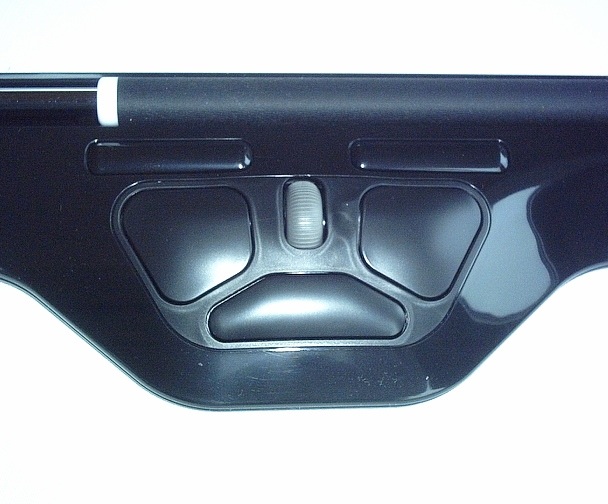
However, the large center button located south of the scrollwheel performs a hybrid function equivalent to a double left click, but with just a single click required to activate it, which is convenient and kind of cool once you get used to it.
The other two smaller buttons just south of the rollerbar work in conjunction with the main left and right click buttons to execute copy and paste functions.
Pressing down on the scroll wheel also activates a scroll lock feature, which enables a speedy freewheeling scroll function similar to what’s possible with some of the excellent weighted freewheeling scroll wheels on Logitech computer mice, only the RollerMouse goes one better yet, since it will auto scroll with minimum effort needed.
This HID compliant device has the drivers “on board” and on either Mac or PC simply needs to be plugged into any empty USB port, without need for a cumbersome connection routine or software driver installs.
A 2002 ergonomics study at a major pharmaceutical company to test the effects of the RollerMouse Station on typing-intensive jobs found that wrist pain was reduced in 70% of the study’s participants using the RollerMouse and right hand pain was reduced 50%. The RollerMouse also scored very high as an alternative to other computer input devices, saving time and increasing productivity over conventional mice. Other measured responses of this study included comfort level, accuracy, overall ease of operation, effort required, pain reported by region, and pain associated with the devices. The group using the RollerMouse responded the most positively and had significant reduction in pain in the shoulder, wrist, hand, and forearm regions. Participants reported less pain after using the RollerMouse for just two weeks.
Another eight month long study, released in 2004, on the impact of the RollerMouse in Verizon call centers, revealed a dramatic improvement in lowering ergonomic risk exposure, user discomfort and motion savings in keyboard and mouse-intensive tasks. One study finding indicated an improvement in elbow discomfort alone by 58%.
The pilot study, conducted by Humantech, the largest occupational ergonomics consulting firm, hypothesized indicated that RollerMouse reduced ergonomic risk exposure for the right hand/wrist, elbow and shoulder when compared to a conventional mouse. Fifty-one customer service representatives from Verizon’s southern California offices participated in the study and were asked to replace their current input device with the RollerMouse station. The control group used their original keyboard and input device that included any of the following: a straight keyboard, wave keyboard, touch pad keyboard and standard mouse. The study group used the RollerMouse station in place of their current input device.
Prior to the installation of RollerMouse, the study group reported discomfort in the upper extremities (i.e., hands/wrists, elbows and shoulders). After the study trial, participants discomfort improved by 24% and elbow discomfort alone was improved by 58% for the study group. Woody Dwyer, CPE, managing consultant for Humantech noted, “93% of the study participants did not want to return to their original workstation set up after the study and many noted an immediate reduction in discomfort in the shoulders, elbows and hands/wrists.
Click here to view a complete copy of the study.
Another Humantech Project called the”Pilot Study: Performance, Risk, and Discomfort Effects of the RollerMouse station,”found that users were able to achieve faster data entry using the RollerMouse, averaging almost 5% increased productivity. Similar findings were established earlier in the year when Contour Design conducted a study of the RollerMouse Station in the one thousand-seat call center of a major U.S. pharmaceutical company. That study discovered a 47% reduction in reported operator pain when using the RollerMouse Station.
The main downside of the RollerMouse Free is in my estimation is its price - it lists at $219.95, with the RollerMouse Pro model slightly cheaper at $199.95 — quite a bit more than you have to pop for a good conventional ergonomic mouse such as Contour’s own Perfit Mouse. However, if the RollerMouse will facilitate greater comfort and productivity at your computer, it could pay for itself pretty quickly.
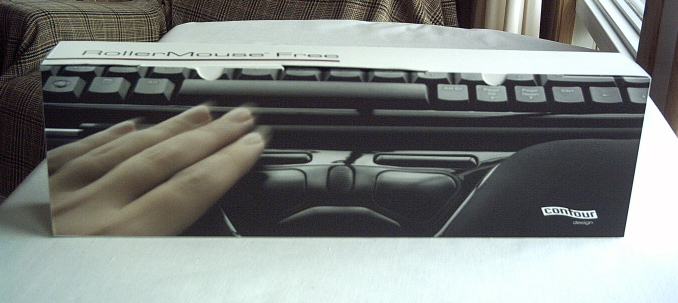
System Requirements:
• Macintosh with available USB port only, no ADB support available
• PC with available USB or PS2 port, serial ports are NOT supported
• Recommended for use with 101 key “straight” style keyboards
• Supported by virtually all operating systems with USB or PS2 support. (Some Operating Systems require driver to enable Scroll Wheel support.
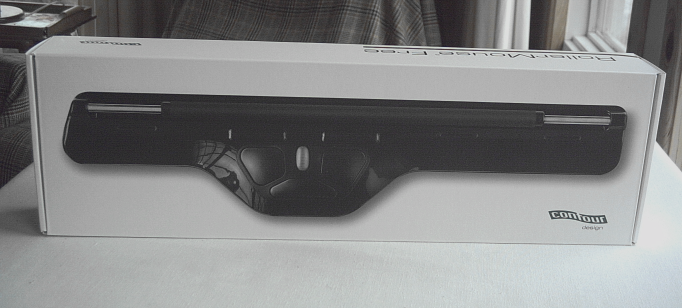
Available in black or white to match Apple keyboards.
RollerMouse PRO - Black - $ 199.99
Either model is available on a 30 day trial basis to institutional users, and both are covered by a two year warranty.
For more information, visit:
http://ergo.contourdesign.com/products/product-detail.aspx?id=50
Note: Letters to PowerBook Mystique Mailbag may or may not be published at the editor's discretion. Correspondents' email addresses will NOT be published unless the correspondent specifically requests publication. Letters may be edited for length and/or context.
Opinions expressed in postings to PowerBook Mystique MailBag are owned by the respective correspondents and not necessarily shared or endorsed by the Editor and/or PowerBook Central management.
If you would prefer that your message not appear in PowerBook Mystique Mailbag, we would still like to hear from you. Just clearly mark your message "NOT FOR PUBLICATION," and it will not be published.
CM